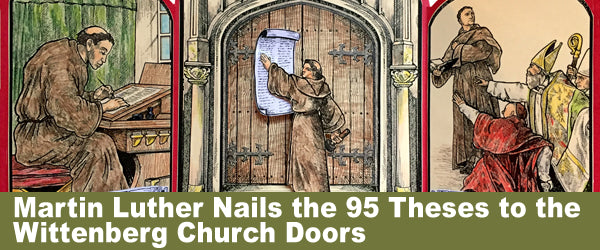
Posted by The Home School in the Woods Team on
Some said he was a “demon in the appearance of a man,” while others said, “he alone is right!”
Whether or not you believe he was holy or a heretic, we know this to be true – Martin Luther is considered to be one of the most influential Christians of all time. After all, the nailing of his 95 Theses to the Wittenberg church doors on October 31, 1517, sparked the Protestant Reformation!
Keep on reading to learn more about the exciting life of Martin Luther and why his 95 Theses changed the course of Western history forever.
We’ll tell you more about our Project Passport that contains hands-on projects to help you teach your kids about other exciting events from the Renaissance and Reformation period.
Who Was Martin Luther?
Martin Luther (1483-1546) was a German theologian who sparked the 16th-century Protestant Reformation, a religious reformation that divided Western Christendom and Roman Catholicism.
Martin Luther’s father, who was a miner, had high hopes for his son. His wish was that he would become a successful lawyer. However, after many years of rigorously studying grammar, rhetoric, and logic, Luther had a life-changing experience.
In July of 1505, Luther found himself stuck outside in a life-threatening thunderstorm. He cried out to the patron saint of miners, St. Anne, and said, “Save me, St. Anne, and I’ll become a monk!”
Before his eyes, the storm quickly passed, and he found himself indebted to a promise. He told his father the disappointing news that he was going to abandon the opportunity to become a lawyer and study to become a monk.
Martin Luther’s Journey to Becoming a Monk
Luther put all of his efforts into becoming a devout monk – just as he had promised. He vigorously studied, prayed, fasted, went without sleep, and even endured freezing temperatures without a blanket.
However, during this time, he had come to find that his relationship with God was primarily founded upon fear. Throughout his studies, he was drawn to the word “righteous” in Romans 1:17, which would later be known as the “Reformation text.”
The verse includes, “the righteous shall live by faith.” This caused Luther to question who could live by faith if they weren’t already righteous? Luther interpreted that anyone who truly believes in Jesus Christ is righteous and, therefore, can live out his commandments.
This changed Luther’s faith dramatically since his Catholic upbringing had led him to try and live a righteous life as an unrighteous sinner. He finally concluded...
“At last meditating day and night, by the mercy of God, I ... began to understand that the righteousness of God is that through which the righteous live by a gift of God, namely by faith… Here I felt as if I were entirely born again and had entered paradise itself through the gates that had been flung open.”
So, what was he to do now?
Why Did Martin Luther Leave the Catholic Church?
It wasn’t long before Luther started sharing this idea with other believers in the church. Suddenly, others were beginning to see his point, too.
On All Saints’ Eve in 1517, Luther posted a public objection toward Wittenberg church, where a preacher named Johann Tetzel stated that congregants could pay to have themselves or a loved one, who was trapped in purgatory, saved from their sins and punishment.
Tetzel stated, “Once the coin into the coffer clings, a soul from purgatory heavenward springs!”
This is when Luther nailed his 95 Theses to the church door and called to have a public debate. Thanks to the Printing Press, the document quickly spread across Germany and made believers question whether or not the pope had the right to issue indulgences.
Martin Luther’s 95 Theses spread all across Europe and started a revolution against the church and its underlying principles.
The Spark of the Protestant Reformation
In 1521, Luther was called to appear before Roman Emperor Charles V in Worms, Germany. He was asked to recant his 95 Theses, to which he replied:
“Unless I can be instructed and convinced with evidence from the Holy Scriptures or with open, clear, and distinct grounds of reasoning ... then I cannot and will not recant, because it is neither safe nor wise to act against conscience.”
The meeting resulted in Luther being deemed a heretic and threatened with excommunication. From there, he fled to Wartburg Castle, where he stayed in hiding. During this time, Luther translated the New Testament into the German language.
As time went on, a religious revolution called the Protestant Reformation took place, which marked the beginning of Protestantism.
Martin Luther’s Impact on Christianity
Martin Luther’s death in 1546 didn’t stop his views from spreading. Nearly 500 years later, his message continues to redefine the basic tenets of Christian belief. Today, the church is still divided because of his findings (Roman Catholicism vs. Protestant).
Although Martin Luther is one of the most controversial figures in Christian history, he is still considered an essential figure to learn about since he changed the course of history as we know it!
If you’re looking for educational homeschool projects about Martin Luther, his 95 Theses, and the Protestant Reformation, check out our Renaissance and Reformation Project Passport, as well as the stand-alone Martin Luther 95 Theses File Folder Project.
Want more “this week in history” blog posts? Sign up for our newsletter on our homepage!


To the homeschoolinthewoods.com admin, Thanks for the educational content!